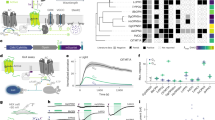Abstract
CLASSES of neurones which are capable of forming synapses with other classes (as distinct from those which actually do so in normal growth) can be defined only by allowing the neurones to show—by their growth in abnormal conditions—what anatomical patterns of connexions they will form and what they will not. It remains to be shown that the orderly connexions that are formed in the normal process of development are but a fraction of the possible connexions that can be revealed by transplantation. As a result of numerous transplantation experiments and the analysis of the resultant synaptic patterns it may one day be possible to delineate sets and subsets of neurones by their preferences and aversions for synaptic contact with other sets and subsets which are so revealed. Where a single neurone can be individually recognized again and again in different preparations, these experimental tests lead to conclusions about the determination of character of single cells, otherwise only groups of neurones can be distinguished.
This is a preview of subscription content, access via your institution
Access options
Subscribe to this journal
Receive 51 print issues and online access
$199.00 per year
only $3.90 per issue
Buy this article
- Purchase on Springer Link
- Instant access to full article PDF
Prices may be subject to local taxes which are calculated during checkout
Similar content being viewed by others
References
Stone, L. S., Ann. NY Acad. Sci., 49, 856 (1948).
Gaze, R. M., Jacobson, M., and Szekely, G., J. Physiol., 176, 409 (1965).
Guth, L., and Bernstein, J. J., Exp. Neurol., 4, 59 (1961).
Mark, R. F., Exp. Neurol., 12, 292 (1965).
Hibbard, E., Exp. Neurol., 13, 289 (1965).
Hibbard, E., Exp. Neurol., 19, 350 (1967).
Maynard, D. M., and Cohen, M. J., J. Exp. Biol., 43, 55 (1965).
Braitenberg, V., Exp. Brain Res., 3, 271 (1967).
Shaw, S. R., Z. Vergl. Physiol., 55, 183 (1967).
Shaw, S. R., Symp. Zool. Soc. (in the press).
Burtt, E., and Catton, W. T., J. Physiol., 125, 566 (1954).
Palka, J., J. Insect Physiol., 13, 235 (1967).
Attardi, D. G., and Sperry, R. W., Exp. Neurol., 7, 46 (1963).
Jacobson, M., and Gaze, R. M., Exp. Neurol., 13, 418 (1965).
Author information
Authors and Affiliations
Rights and permissions
About this article
Cite this article
HORRIDGE, G. Affinity of Neurones in Regeneration. Nature 219, 737–740 (1968). https://doi.org/10.1038/219737a0
Received:
Issue Date:
DOI: https://doi.org/10.1038/219737a0
This article is cited by
Comments
By submitting a comment you agree to abide by our Terms and Community Guidelines. If you find something abusive or that does not comply with our terms or guidelines please flag it as inappropriate.



